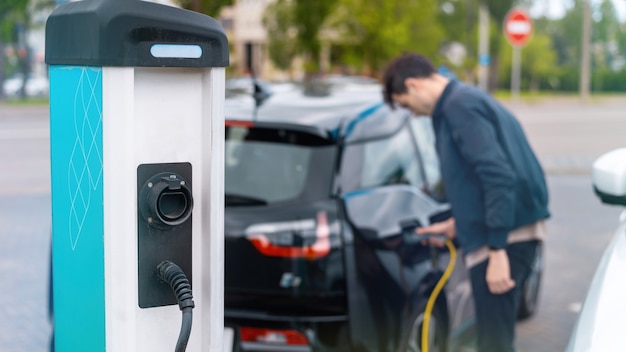
Electric cars are becoming more affordable, albeit slowly. Over the past year, major players like Ford and Tesla have reduced the prices of their popular electric cars. At the same time, brands like Rivian are planning to introduce new, budget-friendly models. Yet, calling electric cars “cheap” is still a stretch, and the idea of buying a brand-new car can be daunting for many potential buyers. In 2022, nearly 74% of all car sales were for used cars, according to Statista. While this percentage might decrease as electric cars become cheaper, many buyers still prefer saving money by purchasing used rather than new.
Purchasing an electric vehicle (EV) doesn’t have to be drastically different from buying a traditional internal combustion engine (ICE) vehicle, but there are some extra considerations. EVs often focus on software and self-driving capabilities, necessitating better computing power. As technology advances faster, EVs might become outdated quicker than ICE vehicles, similar to how a four-year-old smartphone lags behind the latest models. New cars have always brought new features, but the pace of these advancements is noticeably speeding up.
Additionally, carmakers are rapidly improving the essential aspects of electric cars. Advances in battery and charging technology are crucial, as many buyers are interested in cars with a longer range. New EV models capable of covering 350, 400, or even 500 miles on a single charge are forthcoming, though it will take time before these longer-range models are available in the used car market.
When thinking about a used electric car, it’s important to consider more than just better battery technology. There’s still some skepticism surrounding the longevity of car batteries, and it’s understandable. Unlike ICE vehicles, which do not lose range over time, EV batteries degrade. After years of charging and discharging, they will start to hold less energy and provide shorter ranges. However, there are ways to minimize this degradation, such as slowly charging the battery over long periods rather than using fast chargers every time. So, if you can charge your EV at home overnight, your battery is likely to last longer compared to one that relies on fast charging stations.
Despite these concerns, some fears about battery degradation are exaggerated. According to Stacy Noblet, VP of transportation electrification at ICF, the average annual battery capacity loss is only about 1% to 2%. This should not deter consumers from buying used EVs. Moreover, government regulations require EV manufacturers to cover batteries under warranty for at least eight years or 100,000 miles. This doesn’t mean you can get a new battery at the first sign of reduced range, but depending on the battery’s condition, you might manage a replacement near the end of this period.
Matt Smith, deputy editor at CarGurus, notes that battery life can range from 8 to 15 years based on climate conditions. Therefore, knowing the age and condition of a used EV’s battery is essential. If it’s been replaced, the car’s lifespan could extend beyond the warranty period. It’s also crucial to check if the battery warranty is still valid and transferrable, as misuse can void it. Keeping the car’s software updated can help maintain the warranty and enhance battery performance.
Assuming the warranty is intact, it typically covers battery repairs if capacity drops below a certain level. For instance, Tesla’s warranty includes battery repairs or replacement if capacity falls below 70% within eight years. This doesn’t guarantee a brand-new battery but ensures a functional one. Tesla also offers a four-year or 50,000-mile warranty on used cars bought directly from Tesla.
Before finalizing any purchase, it’s wise to get the EV’s battery checked by a certified technician. Sean Tucker, senior editor at Kelley Blue Book, advises getting an independent mechanic to inspect the car. If the seller refuses, it’s best to walk away. With EVs, checking the remaining battery life can be a key factor in price negotiations.
While people usually think a used EV will be cheaper, that’s not always true. High demand can make some used models pricier than new ones, especially if buyers are willing to pay extra to avoid waiting. In addition, many used EVs are not significantly cheaper than new ones, and with available incentives, buying new can sometimes be more cost-effective. The federal government offers up to a $4,000 tax incentive on used EVs and up to $7,500 on new ones. Therefore, to benefit from the incentive, the used EV must be at least $3,500 cheaper than the new model.
The IRS updated its used EV tax credit in 2023, covering 30% of the sale price up to $4,000 for cars over two years old bought from licensed dealers. Buyers must also meet income requirements. You’ll need to do the math to figure out whether a new or used model is financially better for you based on these tax credits.
So, there’s a lot to think about when buying an electric car. First, determine if it will indeed be cheaper. After that, the process of buying a used EV is much like buying new—perhaps even simpler. Unlike ICE vehicles, EVs don’t have components like timing belts or water pumps that need frequent replacement, making inspections easier in some ways.
However, performing due diligence is still necessary. For example, testing an EV’s battery capacity and charging speed during an extended test drive could be beneficial. While inspecting an EV might involve fewer parts, it can still take some time.
Experts agree that used EVs are worth considering and can offer a more affordable entry into electric driving. Batteries can be an issue, but not as significant as many might think. If you thoroughly inspect an EV before purchase and don’t mind a slightly older model, buying a used electric car could be a smart and economical choice.